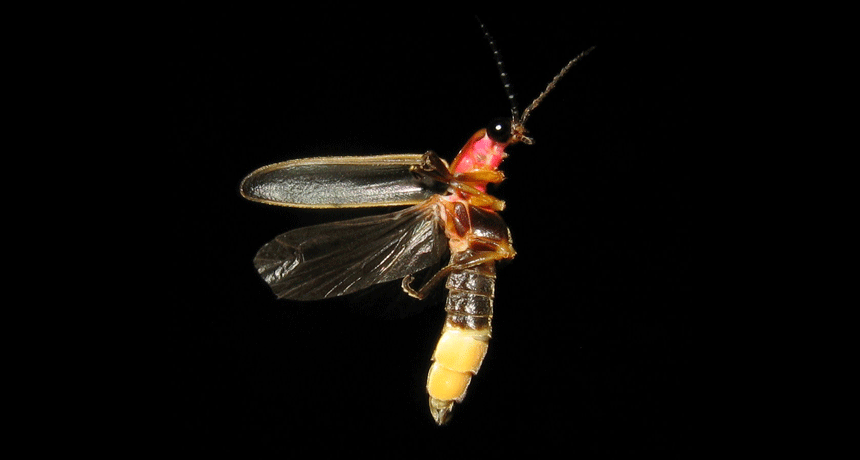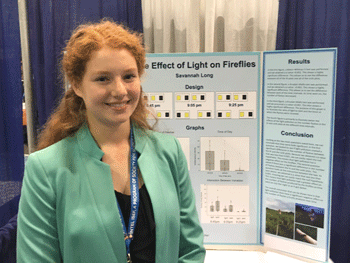Nighttime lights can dim a firefly’s flash
Light at night can mean fewer fireflies, a teen shows

There are many species of fireflies. Savannah Long studied a common North American species, Photinus pyralis.
terry priest/art farmer/Wikimedia Commons(CC-BY-SA 2.0)
LOS ANGELES, Calif. — For many kids, summer evenings are a time for catching fireflies. But in cities and suburbs, night isn’t as dark as it used to be. Lights from buildings and cars brighten the sky, enough that this illumination can be seen from space. And that light could be affecting the fireflies, a Virginia teen has now found. Savannah Long, 17, is a senior at Mountain Vista Governor’s School in Warrenton. And she has discovered that when lamps light the night, fireflies flit away.
Savannah had been struggling to come up with an idea for her science research project. “I was stuck because I didn’t know what I wanted to do,” she says. Then, her high school class visited the University of Virginia’s Blandy Experimental Farm in Boyce. There, the teen heard a talk by Ariel Firebaugh, a graduate student in biology at the University of Virginia in Charlottesville. Firebaugh has been studying how light affects fireflies at Blandy Farm.
Firebaugh’s talk reminded Savannah of her firefly-catching days. “I didn’t think I could make something I enjoyed as a kid into actual research,” she says. “That was really cool.” The teen was especially taken with the idea that light pollution could somehow affect the insects. “A lot of people don’t look at sensory pollution,” such as light or sound pollution, she notes. “They look at things like air pollution and water pollution.”
With some help from Firebaugh, Savannah set up an experiment last summer at the Blandy Farm. From the end of June to the beginning of August, Savannah made seven evening visits to eight plots in a meadow. Four of the sites were naturally dark. Four others had been lit with 60-watt flood lights — the kind used for lighting a driveway or yard.
During each visit, the teen stood at the edge of each plot and counted the number of firefly flashes she saw in one minute. The flashes of Photinus pyralis blinked in the shape of a J. Dot-shaped flashes marked a different species, P. versicolor. Then she moved on to the next plot and repeated the count. She did this three times each evening, at 8:45 p.m., 9:05 p.m. and 9:25 p.m.
The fireflies definitely preferred the darkness, Savannah found. At 8:45 p.m., dark plots had twice as many flashes as lit plots. By 9:05 p.m., the dark plots had four times as many flashes as the brighter areas, and by 9:25 p.m., the dark plots had eight times as many flashes.

Savannah brought her results here to the Intel International Science and Engineering Fair (ISEF). This year, the competition brought together almost 1,800 high school students from more than 75 countries to share their scientific research. (ISEF was created by Society for Science & the Public and is sponsored by Intel. The Society also publishes Science News for Students and this blog.)
The teen’s results are similar to those collected by Firebaugh and her University of Virginia colleague Kyle Haynes. In another set of experiments, the pair showed that light pollution reduced flashing activities of fireflies by 70 percent. Because fireflies glow to attract mates, less flashing meant less flirting. And so light pollution also reduced the fireflies’ mating success. Firebaugh and Haynes published their results in the December 2016 Oecologia.
Scientists have become worried that firefly populations may be declining. There could be many reasons for that, but but light pollution may play some role.
Unfortunately, in cities and suburbs, there’s not really much that people can do about light pollution, Savannah notes. Street lamps and car headlights help to keep people safe. But in the country, she says, it’s another matter. Many people in the country leave on lights at night, she notes. But those flood lamps outside barns or garages don’t always need to be on. “Houses that have outside lights, turn them off,” she says. “One more step to saving the fireflies.”
Follow Eureka! Lab on Twitter







